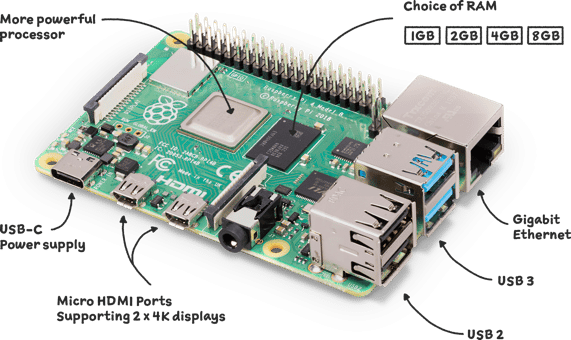As Raspberry Pi devices become increasingly popular, the need for effective device management solutions has also grown. In this article, we will take a comprehensive look at how to manage Raspberry Pi devices.
What is a Raspberry Pi?
A Raspberry Pi is a credit card sized computer that can be used for a variety of purposes. It is a popular choice for building projects as it is relatively cheap and easy to use. But it is also often used as a proof of concept device for industrial IoT projects. The reason for this is that most Linux gateways and industrial SBC (single board computers) are based on a Debian Linux image, the same the Raspberry Pi operating system is relying on as well. Many industrial distributions are in fact very much inspired by the Raspbian OS.

The Benefits of Using a Raspberry Pi
There are many benefits to using a Raspberry Pi over other types of computers. They are energy efficient, which makes them ideal for use in projects where power consumption is a concern. They are also very versatile and can be used for a wide range of applications. In addition, they are fairly inexpensive and it is easy to port any application from a Raspberry Pi to an industrial computer. In many cases there are even industrial versions of the Raspberry Pi available that are sufficient for industrial applications and environments.
How to Get Started with Raspberry Pi Device Management
The first step to managing Raspberry Pi devices is to identify what needs to be managed. This will vary depending on the project or application that the devices are being used for. Once the scope of management has been determined, the next step is to choose a management solution.
For a single device it is of course possible to ssh into the device and do this manually. If you don’t install the headless version you even have a desktop UI to do the management. For hobby projects this can be sufficient, but this will very soon become very hard to manage if there are multiple devices involved or if the device is located at a remote location.
Which Options Are Available for Device Management?
- automate ssh logins – this is very cumbersome and error prone. In any case the ssh port 22 should not be kept open towards the internet
- create a pre-build image with all security in place. This will work well until there are changes that need to be executed. Here is a short manual how to create a Raspberry Pi golden image.
- use a device management software that will handle all this for you. There are different solutions in the market. The above link introduces one that allows you to use up to 2 devices for free.
The Best Method To Manage Raspberry Pi Devices
We believe that the best current option to manage large fleets of Raspberry Pis is to use a pull based device management system. The concept of pull based device management solves the problem that not all devices in a fleet are online all the time. Even if devices are offline for a prolonged time they will pull the last configuration state and converge to that. Another advantage is that the communication is initiated by the device management agent on the edge device. This means that we do not need to know any IP addresses and this works through basically any firewall or NAT. The agent will autonomously converge to the state defined in the configuration file. Thus, any software update or library update will automatically use the latest version. The configuration management engine in such a solution will also help to configure and define all the Linux specific settings such as users, firewall, ssh keys, NTP servers and much more.
Overall, a device management will provide you with all the features to manage and update your device, your software, the operating system and much more.
Additional Useful Features to Operate Raspberry Pi Devices Remotely
The main concern for IoT device management is of course the over the air (OTA) update. But any time you operate a fleet of remote devices additional functionality is very useful. Specifically, a built-in VPN for remote access allows simple and secure connectivity to the devices in order to debug or check log files. This can be achieved with all external ports closed, a necessity to operate the devices securely. In addition, the remote access functionality of qbee allows you to map any port from the remote Raspberry Pi to your localhost port. This includes webservers, databases or VNC remote desktop access on port 5900. A neat feature of qbee-connect is that you can even access other devices within the same network through a technique called ssh port forwarding. Below you see a screenshot of our Docker orchestration UI which allows you to manage Docker containers on large fleets of Raspberry Pis. And here you find how to install Docker on a RPI.

During many fleet deployments it is also important to follow the current condition of the devices. Therefore an integrated metric monitoring is following all standard device metrics such as CPU usage, load average, memory consumption or file system usage. The inventory module keeps track of all installed debian packages and checks against the CVE security database if any vulnerabilities are detected. This flags the libraries that need to be updates.
Conclusion
Raspberry Pi devices are becoming increasingly popular due to their low cost and high performance. As more and more people adopt these devices, the need for effective device management solutions has also grown. In this article, we have taken a comprehensive look at how to manage Raspberry Pi devices and what functions you can expect in an IoT device management solution. Check out the qbee IoT device management solution. If you want to create IoT results quickly it might also be of interest to have a look at how the Node-RED low-code platform can help you.

Why should you use device management?
Improve Security
Benefit from the security of a SaaS device management solution. Keep you devices save.
Save Time
Don't ssh into devices. This is error prone and costs a lot of time. Rather use our remote scripting engine.
Save Costs
Developers want to create exciting applications instead of being tangled up in costly maintenance.







